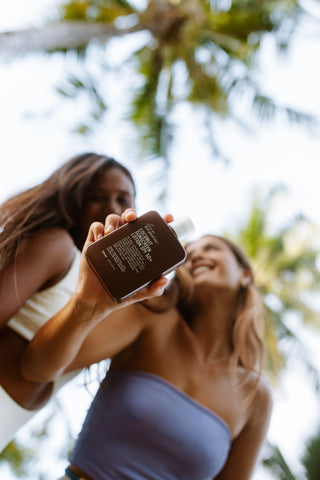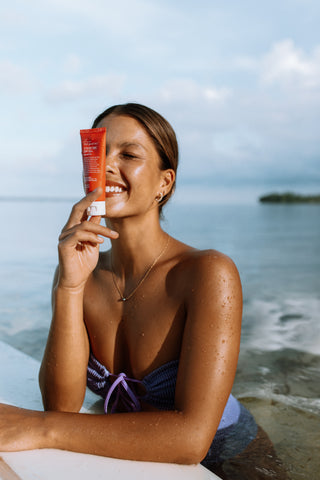Each of these terms when referring to sunscreen, can be confusing. Are you ready?
Sunscreen is necessary for protecting the skin against the damaging effects of the sun's UV rays. However, choosing the right sunscreen can be a confusing task, particularly when faced with the terminology surrounding chemical and mineral (physical) sunscreens. So let's explore the differences between chemical and mineral sunscreens, how they work, and what to consider when choosing a sunscreen that is best suited for individual needs.
What are Chemical Sunscreens?
Chemical sunscreens are commonly referred to as the most used type of sunscreen. The filters within sunscreen chemicals are formulated using a combination of organic chemicals that contain carbon, which act as UV filters. The active ingredients within chemical SPF tend to work by absorbing the UV light that hits the skin and converting them into heat, which is then released from the body.

What are Mineral Sunscreens?
Physical or mineral sunscreen, on the other hand, uses minerals such as Zinc Oxide or Titanium Dioxide as their UV filter. Much of the information out there describes mineral sunscreens to work differently to chemical sunscreens, in that they reflect and scatter UV light.
But that's not necessarily the case anymore...
It’s important to note that this understanding comes from historical research when mineral particles were much larger, either non-micronized or non-nano (unlike our Mineral Sunscreen SPF50+). Keep in mind that “micronized” does not mean “nano”. To learn more about micronized zinc technology, refer to our blog.
In fact, experts current research in improving communications on sunscreen choice iterate that with new developments in formulating mineral sunscreens, physical UV filters (Zinc Oxide and Titanium Oxide) act in the same way as chemical UV filters, by absorbing UV light and converting them into heat.
Modern formulations are becoming increasingly popular as they have reduced “white cast”, which mineral sunscreens can be known for leaving, and allow for an easier application. On another note, physical sunscreen is usually preferred by those with sensitive, or blemish prone skin.
So, How Do Chemical and Mineral Sunscreens Work? And How Do I Know Which One is Best for Me?
Both chemical and physical (mineral) sunscreens work to protect the skin by absorbing UV rays from the sun and converting them to heat. This heat is then released into the skin in a harmless fashion.
It can be believed that to some extent the actives create a physical barrier that reflects or “scatters” these rays away from the skin's surface. However, as mentioned, this comes from historical research when mineral particles were much larger, leaving a thick “white cast” - think of the lifeguards with those iconic white noses at the beach.
Studies have shown that modern physical sunscreens can reflect up to 5% of UV rays, while absorbing the rest. Ultimately, mineral sunscreens often work by absorbing UV, while scattering only a small amount.
Many dermatologists recommend mineral sunscreen formulations due to the fact that they have “less” ingredients, i.e. strictly using Zinc Oxide or Titanium Oxide as the single UV filter. This can be especially enticing if you suffer from sensitive skin, as less ingredients may mean a lesser chance of having a reaction.
Since both physical and chemical sunscreens work in the same way, pick a sunscreen that you actually want to wear.
The most important thing to consider when choosing a sunscreen is to ensure that it provides Broad Spectrum SPF50 or 50+ protection, meaning it blocks both UVA and UVB rays. Sunscreens that are labeled as "Broad Spectrum" provide coverage against both types of UV rays, helping to protect against both short and long-term skin damage.

UVA and UVB Rays
UVB has the largest effect on the top layer of skin overall. This is what causes the redness and burning.
While on the other hand, UVA rays reach deep into the layers of the skin which causes aging and wrinkling. These are the harmful rays that can lead to skin cancer. Think of UVA (A=aging) and UVB (B=burning).
The best sunscreens use a mixture or combination of filters to ensure you are protected from both types of UV rays.
Think of the different UV filters used like music notes. They each work in their own way to cover different levels of UV rays, just like music notes represent the pitch, speed and rhythm of a song.
What Does "Organic" Mean in Sunscreen Terminology?
Organic sunscreen is something often misinterpreted.
The sunscreen market is saturated with products that use claims such as ‘natural’ or ‘organic’, but are they really?
When you see a sunscreen labeled as ‘organic’, you may associate it as a ‘healthier’ or ‘safer’ option. However, ‘organic’ (when referring to sunscreen) actually refers to SPF formulations composed of organic chemicals (carbon containing UV filters), aka, chemical sunscreens. To learn more, read our blog “What is Organic Sunscreen”.
Mineral or zinc sunscreen on the other hand, are "inorganic", meaning they contain metal oxides or are carbon-free. These formulations can often be considered all ‘natural’, but this is often misleading. Whereas these elements may occur naturally on earth, they still need to be processed in a lab to assume their role in sunscreens.
The Australian Certified Organic association highly regulates the use of the term ‘organic’ in sunscreen products. However, mineral sunscreens that contain 20-25% zinc oxide in their formula can still make the "organic" claim.
It is important to note that all sunscreens contain some form of chemical, whether organic or inorganic, that has been altered in a laboratory to block the sun’s rays, meaning no sunscreen is entirely "natural”.
Mineral vs Chemical Sunscreen: The Actual Difference
The key difference between mineral and chemical sunscreens is the type(s) of UV filter used.
Chemical sunscreens use a variety of different UV filters, providing more options when choosing a sunscreen. These formulations are often thinner, making them more ideal for daily use.
While physical sunscreens can feel heavier on the skin than chemical sunscreens, they are often preferred by those with sensitive skin as they contain fewer active ingredients and can be less likely to cause irritation. Other Zinc Oxide benefits are that it can also be effective at reducing redness and inflammation from acne prone skin and other conditions like rosacea.

For instance, our Mineral Sunscreen SPF 50+ is a mineral or physical sunscreen. Using Zinc Oxide as its only UV filter this means that it has minimal ‘active ingredients’. It is formulated using micronized zinc technology, allowing for a more lightweight feel and rubs in clear. Nonetheless, as it is possible to react to any ingredient in sunscreen, so fewer ingredients can mean a lower chance of having adverse reactions, like skin irritation.

On the other hand our range of chemical sunscreens, which includes our best selling Sensitive Sunscreen and Coconut Sunscreen, are made up of chemical UV filters, i.e. do not contain Zinc Oxide or Titanium Dioxide. Most of our sunscreen formulas are formulated using a combination of ‘organic’ filters, including our SPF moisturisers, like Good Morning SPF 50 daily face lotion - now available in a fragrance free option.
Offering both chemical and mineral (physical) sunscreens is really about providing options for different tastes and skin types, while still providing adequate and effective sun protection.
Our Sticky Zinc SPF50+ is made up of both physical and chemical filters. This is to ensure you have the best possible coverage and effective Broad Spectrum protection from both types of UV rays. This formula in particular is great for adventures and great when spending time in the water, as it is made with tinted iron oxides, so can be more easily noticeable when it's time to reapply. It will rub in smoothly and evenly without leaving a white cast. The physical and chemical filters used in this consist of Zinc Oxide and a combination of chemical ingredients, providing a key difference to other zinc sunscreens on the market.
Zinc sunscreen will always feel a little bit ‘heavier’ on your skin when compared to chemical sunscreens. However, if you have very sensitive skin, like a toddler or baby, then you may not be too fussed about the ‘feel’ so much.
What to Consider and How to Choose the Right SPF.
For the vast majority when choosing a sunscreen, it is essential to select one that provides Broad Spectrum coverage, has a minimum sun protection factor of 50 or higher, and is water resistant. It is also important to consider individual skin type, any sensitivities or allergies, and the intended use of the sunscreen. To avoid irritation, remember to always patch test when trying new products for the first time.
For those with sensitive skin, physical sunscreens may be the preferred choice as they contain fewer active ingredients and are less likely to cause irritation. Combination filters, such as those found in chemical sunscreen ingredients, may provide more complete UV coverage than zinc-only, physical sunscreens and may feel more lightweight on your skin. They are usually water resistant for longer periods too.
Be sure to check out our entire range of sunscreens to see what best fits your skin! And remember, there is no ‘black and white’ way of choosing sunscreen. It’s simply what feels the best on your skin!
Use sunscreen liberally and reapply according to product directions. Avoid prolonged exposure. Sunscreen is only one component of sun protection, it is important to wear protective clothing such as long sleeves, hats and protective eyewear when exposed to the sun. Remember to apply sunscreen 20 minutes before sun exposure.

